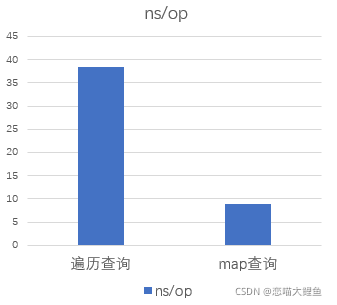您好,登錄后才能下訂單哦!
您好,登錄后才能下訂單哦!
這篇文章主要介紹“怎么用Go判斷元素是否在切片中”的相關知識,小編通過實際案例向大家展示操作過程,操作方法簡單快捷,實用性強,希望這篇“怎么用Go判斷元素是否在切片中”文章能幫助大家解決問題。
如何判斷元素是否在切片中,Golang 并沒有提供直接的庫函數來判斷,最容易想到的實現便是通過遍歷來判斷。
以字符串切片為例,判斷字符串切片中是否包含某個字符串。
// InSlice 判斷字符串是否在 slice 中。
func InSlice(items []string, item string) bool {
for _, eachItem := range items {
if eachItem == item {
return true
}
}
return false
}這種實現時間復雜度是 O(n),n 為切片元素個數。
如果切片長度比較短(10以內)或者不是頻繁調用,該性能是可以接受的。但是如果切片長度較長且頻繁調用,那么這種方法的性能將無法接受,我們可以借助 map 優化一波。
先將 slice 轉為 map,通過查詢 map 來快速查看元素是否在 slice 中。
// ConvertStrSlice2Map 將字符串 slice 轉為 map[string]struct{}。
func ConvertStrSlice2Map(sl []string) map[string]struct{} {
set := make(map[string]struct{}, len(sl))
for _, v := range sl {
set[v] = struct{}{}
}
return set
}
// InMap 判斷字符串是否在 map 中。
func InMap(m map[string]struct{}, s string) bool {
_, ok := m[s]
return ok
}注意:使用空結構體 struct{} 作為 value 的類型,因為 struct{} 不占用任何內存空間。
fmt.Println(unsafe.Sizeof(bool(false))) // 1
fmt.Println(unsafe.Sizeof(struct{}{})) // 0雖然將 slice 轉為 map 的時間復雜度為 O(n),但是只轉換一次可以忽略。查詢元素是否在 map 中的時間復雜度為 O(1)。
我們可以看下在元素數量為 26 的情況下,取中位元素,做個基準測試(benchmark),對比下二者的查詢性能。
func BenchmarkInSlice(b *testing.B) {
for i := 0; i < b.N; i++ {
InSlice(sl, "m")
}
}
func BenchmarkInMap(b *testing.B) {
m := ConvertStrSlice2Map(sl)
for i := 0; i < b.N; i++ {
InMap(m, "m")
}
}執行測試命令輸出:
D:\code\gotest\contain>go test -bench=.
goos: windows
goarch: amd64
pkg: main/contain
cpu: Intel(R) Core(TM) i7-9700 CPU @ 3.00GHz
BenchmarkInSlice-8 30564058 38.35 ns/op
BenchmarkInMap-8 134556465 8.846 ns/op
PASS
ok main/contain 3.479s
測試結果中,看到函數后面的 -8 個表示運行時對應的 GOMAXPROCS 的值。接著的一串很大的數字表示運行 for 循環的次數,也就是調用被測試代碼的次數,最后的38.35 ns/op表示每次需要花費 38.35 納秒。
以上是測試時間默認是 1 秒,也就是1秒的時間,如果想讓測試運行的時間更長,可以通過 -lunchtime 指定,比如 5 秒。
性能對比:

可以預料到的是隨著切片長度增長,性能差距會越來越大。
我們可以借助空接口 interface{} 來實現任意類型的切片轉換為 map,方便調用方使用。
// ToMapSetStrictE converts a slice or array to map set with error strictly.
// The result of map key type is equal to the element type of input.
func ToMapSetStrictE(i interface{}) (interface{}, error) {
// check param
if i == nil {
return nil, fmt.Errorf("unable to converts %#v of type %T to map[interface{}]struct{}", i, i)
}
t := reflect.TypeOf(i)
kind := t.Kind()
if kind != reflect.Slice && kind != reflect.Array {
return nil, fmt.Errorf("the input %#v of type %T isn't a slice or array", i, i)
}
// execute the convert
v := reflect.ValueOf(i)
mT := reflect.MapOf(t.Elem(), reflect.TypeOf(struct{}{}))
mV := reflect.MakeMapWithSize(mT, v.Len())
for j := 0; j < v.Len(); j++ {
mV.SetMapIndex(v.Index(j), reflect.ValueOf(struct{}{}))
}
return mV.Interface(), nil
}
func main() {
var sl = []string{"a", "b", "c", "d", "e", "f", "g", "h", "i", "j", "k", "l", "m", "n", "o", "p", "q", "r", "s", "t", "u", "v", "w", "x", "y", "z"}
m, _ := ToMapSetStrictE(sl)
mSet = m.(map[string]struct{})
if _, ok := m["m"]; ok {
fmt.Println("in")
}
if _, ok := m["mm"]; !ok {
fmt.Println("not in")
}
}運行輸出:
in
not in
上面的轉換函數ToMapSetStrictE()已經放到開源 Go 工具庫 go-huge-util,可直接通過 go mod 方式 import 使用。
import (
huge "github.com/dablelv/go-huge-util"
)
// 使用 go-huge-util
m, _ := huge.ToMapSetStrictE(sl)
mSet = m.(map[string]struct{})
// 或使用進一步封裝的函數,不用再斷言
mSet := huge.ToStrMapSetStrict(s)上面其實是利用 map 實現了一個 set(元素不重復集合),然后再判斷某個 set 中是否存在某個元素。Golang 標準庫并沒有 set,但是我們可以用 map 來間接實現,就像上面那樣子。
如果想使用 set 的完整功能,如初始化、Add、Del、Clear、Contains 等操作,推薦使用 Github 上成熟的開源庫 golang-set,描述中說 Docker 用的也是它。庫中提供了兩種 set 實現,線程安全和非線程安全的 set。
golang-set 提供了五個生成 set 的函數:
// NewSet creates and returns a reference to an empty set. Operations
// on the resulting set are thread-safe.
func NewSet(s ...interface{}) Set {}
// NewSetWith creates and returns a new set with the given elements.
// Operations on the resulting set are thread-safe.
func NewSetWith(elts ...interface{}) Set {}
// NewSetFromSlice creates and returns a reference to a set from an
// existing slice. Operations on the resulting set are thread-safe.
func NewSetFromSlice(s []interface{}) Set {}
// NewThreadUnsafeSet creates and returns a reference to an empty set.
// Operations on the resulting set are not thread-safe.
func NewThreadUnsafeSet() Set {}
// NewThreadUnsafeSetFromSlice creates and returns a reference to a
// set from an existing slice. Operations on the resulting set are
// not thread-safe.
func NewThreadUnsafeSetFromSlice(s []interface{}) Set {}下面借助 golang-set 來判斷切片中是否存在某個元素。
package main
import (
"fmt"
mapset "github.com/deckarep/golang-set"
)
func main() {
var sl = []interface{}{"a", "b", "c", "d", "e", "f", "g", "h", "i", "j", "k", "l", "m", "n", "o", "p", "q", "r", "s", "t", "u", "v", "w", "x", "y", "z"}
s := mapset.NewSetFromSlice(sl)
fmt.Println(s.Contains("m")) // true
fmt.Println(s.Contains("mm")) // false
}關于“怎么用Go判斷元素是否在切片中”的內容就介紹到這里了,感謝大家的閱讀。如果想了解更多行業相關的知識,可以關注億速云行業資訊頻道,小編每天都會為大家更新不同的知識點。
免責聲明:本站發布的內容(圖片、視頻和文字)以原創、轉載和分享為主,文章觀點不代表本網站立場,如果涉及侵權請聯系站長郵箱:is@yisu.com進行舉報,并提供相關證據,一經查實,將立刻刪除涉嫌侵權內容。